
Entering the European market for fashion sportswear
Fashion sportswear is a staple in European wardrobes and a major product category for most brands and retailers. This type of apparel has become popular because of changing values and behaviours in Europe. More people are focusing on health and wellness, leading to more physical activity than ever before. The COVID-19 pandemic also accelerated the already popular comfort dressing movement across all fashion segments.
Contents of this page
- What requirements must fashion sportswear comply with to be allowed on the European market?
- Through which channels can you get fashion sportswear on the European market?
- What competition do you face on the European fashion sportswear market?
- What are the prices of fashion sportswear on the European market?
1. What requirements must fashion sportswear comply with to be allowed on the European market?
You need to comply with several requirements when you export fashion sportswear to Europe. Some requirements are mandatory: both legal and non-legal. Other requirements are voluntary but meeting them can give you a competitive advantage. Some requirements only apply to niches in the fashion sportswear market.
What are mandatory requirements?
There are a lot of legal requirements for exporting fashion sportswear to Europe, including ones that concern product safety, the use of chemicals (REACH), quality and labelling. Fashion sportswear for children has special consumer safety requirements too. Check the EU Access2Markets online helpdesk for an overview.
Follow these steps to ensure that your product complies with the relevant legal requirements:
- Make sure your product complies with the EU’s General Product Safety Directive (GPSD: 2001/95/EC). If your buyer supplied the product design, it is their responsibility to guarantee it is legally safe for consumers to use.
- Make sure you comply with the EU’s REACH Regulation. This restricts the use of chemicals in apparel and trims, including certain Azo dyes, flame retardants, waterproofing and stain-repelling chemicals, and nickel. Test materials before production to prevent non-compliance.
- Pay special attention to the following safety standard that applies to fashion sportswear for children: EN 14682. This standard contains requirements to ensure that cords and drawstrings are placed safely on apparel for children up to 14 years.
- Specify the material composition of every item of fashion sportswear that you export to the EU, in line with Regulation (EU) 1007/2011. Check the EU Access2Markets online helpdesk on how to do it.
- Do not violate any Intellectual Property (IP) rights and do not copy or share designs with other buyers. If your buyer provides the design, they will be liable if the item is found to violate a property right.
Additional regulations for the use of chemicals
Some EU countries have additional national regulations for specific chemicals. For example, Austria, Finland, Germany, Norway and the Netherlands have specific regulations for formaldehyde in textiles. Austria, Denmark, Germany and the Netherlands also have specific regulations for PCP, while Germany also has regulations for dispersing dyes in textiles. Switzerland has its own regulation for chemicals: the ORRChem. The UK’s REACH regulation came into force on 1 January 2021 after the country left the EU.
Tips:
- Read the CBI study on buyer requirements for an extensive overview of the legal, non-mandatory and niche requirements you will face as an exporter of fashion sportswear to Europe.
- Check the EU Access2Markets online help desk for an overview of all the legal requirements for your product.
- Be aware that illegal branding and copying of fashion sportswear items is common in the industry. Make sure that your buyer has permission to use the brand name, logo and designs.
Figure 1: Tracksuit pants and tops are a staple in many Europeans’ wardrobes
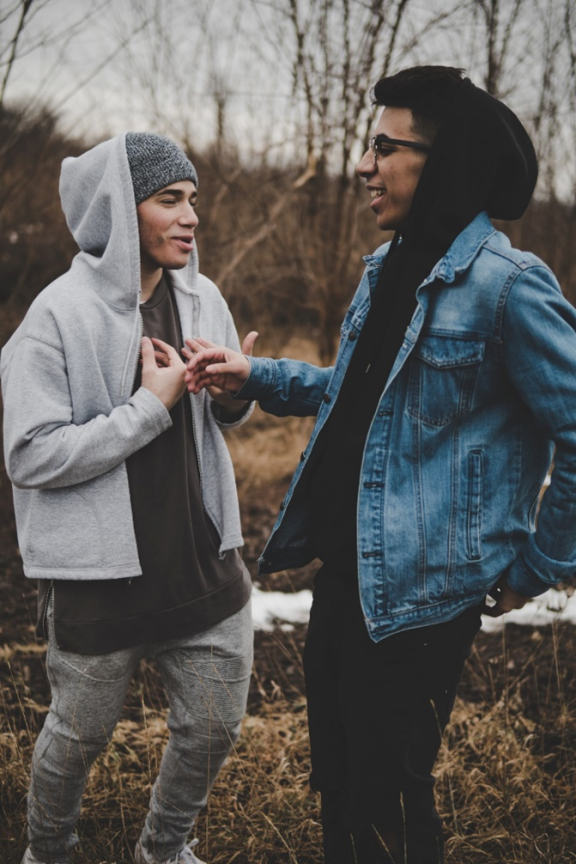
Source: whereslugo on Unsplash.
What additional requirements and certifications do buyers often have?
Buyers may confront you with additional, company-specific terms and conditions. These requirements are usually written down in a buyer manual. By signing a contract with your buyer, you confirm that you will comply with all the requirements listed in the manual. You will be held accountable if there is a problem after the delivery of an order. If a buyer does not have a manual, make sure all terms and conditions are clear and agreed beforehand to avoid unpleasant surprises. The following topics may be included in a buyer manual.
Payment terms
For first-time orders, European buyers may give you a down payment via bank transfer (e.g. 30%). They will pay the rest (70%) once the order has been completed, again via bank transfer. Buyers may also give you a bank guarantee. This statement guarantees that the sum will be paid at a certain date.
Another payment method is the L/C (Letter of Credit). With L/Cs, the buyer’s bank must pay the supplier once both parties meet the conditions they have agreed upon. This is the safest payment method for a manufacturer. An L/C can also be used to get finance to purchase materials. However, many buyers have stopped using L/C payments because they block their cash flow. The administrative cost in case of changes in delivery terms is also high. Be aware that L/Cs do not offer financial protection against bankruptcies.
For further orders, most European buyers ask for a TT (Telegraphic Transfer/Open Account) after 30, 60, 90 or sometimes even 120 days. This means you, as a manufacturer, finish the production and hand over the shipment to the buyer, including the original documents, before payment is due. The payment will be made after the number of days that you have agreed on with the buyer. This is a risky payment agreement because you take full financial risk as manufacturer.
Delivery terms
Free on Board (FOB) is the standard Incoterm that buyers and sellers use to agree on delivery of goods. With FOB, the buyer becomes responsible for the goods once you have delivered them to the vessel. Due to rising shipping costs and risks involved with sea travel via the Red Sea, some buyers may ask you to agree on Delivery Duty Paid (DDP). This means you are responsible as a seller for the goods throughout their entire journey, except for unloading by the buyer. This is the riskiest Incoterm for manufacturers, so watch out!
Nominated suppliers
Some buyers may require you to source materials (fabrics, trims, labels, packing materials) from a specific supplier. This means that you are responsible for the ordering, delivery and payment of the materials (but not the quality, as this is confirmed beforehand by the buyer). This may negatively affect your flexibility, costs, speed and liquidity. Always discuss locally available solutions with your buyer to possibly replace nominated suppliers.
Acceptance quality limit
To guarantee product quality, your buyer may set an acceptance quality limit (AQL). This refers to the worst quality level that is still acceptable. For instance, AQL 2.5 means that your buyer will reject a batch if more than 2.5% of the items are defective. Defects are classified into critical, major and minor defects. Buyers will specify their expectations in the inspection protocols. Industry network Eurofins gives the following general definitions:
- Critical: a defect that fails to meet mandatory regulations and/or affects consumer safety.
- Major: a defect that leads to product failure and reduces the product’s useability and/or saleability.
- Minor: a defect that deviates from quality standards but is not likely to reduce the product’s useability or saleability.
Packaging requirements
Typically, your buyer will give you instructions on how to package the order. If you agree on delivering Free on Board (FOB), your buyer will clear customs in the country of import. It is their responsibility to ensure the instructions on the packaging comply with EU import procedures.
Always try to reduce the environmental impact and financial cost of packaging materials. You could try using materials made from recycled cardboard or biodegradable plastics.
Restricted substances
Ask your buyer if they use a Restricted Substances List (RSL). These lists are often inspired by the guideline on safe chemicals use from the Zero Discharge of Hazardous Chemicals (ZDHC) foundation. Download the ZDHC Conformance Guidance here.
Transparency
Supply chain transparency is key for the European apparel industry, motivated by ever stricter laws at EU and national levels. For instance, the EU’s new Corporate Sustainability Due Diligence Directive (CSDDD) and the Corporate Sustainability Reporting Directive (CSRD) require larger European companies to report on how they manage social and environmental risks.
Transparency means you should disclose information about your operations to buyers and help them gain as much insight as possible into their entire supply chain.
Equality
Your buyer may also require you to pay attention to diversity and inclusion in your workforce. All individuals in your company should have equal opportunities, regardless of gender, race, religion or other characteristics. This can result in greater creativity, innovation and problem-solving.
Animal welfare
If you use wool, animal welfare is a major concern. Buyers may require that you only use RWS-certified wool. If you use merino, buyers may require that you only use non-mulesing wool.
Regenerative agriculture
Organic cotton is popular among European fashion sportswear brands. Adidas and Superdry are two such examples. Efforts to make cotton production more sustainable have expanded to include ‘regenerative agriculture’. This concept is focused on phasing out harmful fertilisers and pesticides and ‘regenerating’ nature, including biodiversity, soil health and water.
Several large European apparel retail groups have set goals in this area, including H&M and Inditex. Control Union recently introduced the first certification for regenerative agriculture: regenagri.
Carbon footprint
Many European brands have committed to climate neutrality. As an example study H&M’s climate goals, which have been verified by the Science Based Targets Initiative. Calculating the carbon footprint of an apparel item is a complicated process, which starts by measuring your emissions carefully before reducing them. Several organisations have set benchmarks for certain materials and products. Check CBI’s tips to go green for more information.
Recycling
The EU is introducing new legal measures to increase circularity, including new directives on the durability and ecodesign of textile products and a ‘right to repair’. The EU is also considering the introduction of an EU-wide EPR for apparel (extended producer responsibility). This makes companies responsible for how their products are disposed of, recycled or repaired. Some countries already have national EPR schemes. Recycling and repurposing materials helps your buyers reduce waste and save resources.
Certification
Many European buyers require suppliers to get certified for sustainable and/or fair production or the use of sustainable materials. The following standards and certifications are the most popular in Europe. Note that BSCI is almost a standard requirement for many European apparel companies. For a more elaborate overview of popular standards, read CBI’s study on buyer requirements.
Table 1: Europe’s most popular standards
| Name of standard | Logo | Type of compliance | Further information on getting certification |
| Amfori BSCI |

| Social | On invitation by buyers. Amfori provides a list of organisations that can perform an audit |
| WRAP | 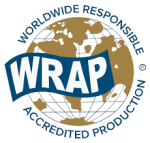
| Social | Check the WRAP certification process here |
| B-Corp | 
| Social, environmental | Check the B-Corp certification process here |
| OEKO-TEX® STeP |
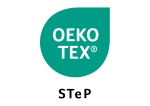
| Social, environmental | Check the OEKO-TEX® STeP application process here |
| GOTS | 
| Social, environmental (organic production) | GOTS provides a list of organisations that can perform an audit |
| Recycled Claim Standard | 
| Environmental (material recycling) | Check how to get certified |
Source: FT Journalistiek
Tips:
- Read the buyers’ manual carefully and do not be afraid to negotiate terms and conditions before signing an agreement. Never agree to comply with requirements you cannot realistically meet.
- Do not take financial risks with new buyers. Check their credibility, insure your orders via an insurance company or insist on a Letter of Credit. If you agree to an extended payment, do not forget to calculate and add interest.
- Provide buyers with as much information about your product as possible. The more information you can give the buyer about the origin of your materials, the better.
- Several assessment tools can help you evaluate materials. These include the Higg Materials Sustainability Index, the Preferred Fiber & Materials (PFM) Benchmark and the sustainable materials guide by MODINT.
Product design and development
European buyers are always looking for special styles, materials and designs that will help them stand out in the market. In recent years, the following interesting innovations have been applied to fashion sportswear.
- Performance-increasing materials, such as special knits that improve blood circulation or give extra support in specific body areas.
- Integrated wearable technologies, such as headphones, pedometers, heart rate and blood pressure sensors, etc.
- Light-weight fabrics and insulation materials.
- Highly breathable materials.
- Moisture-wicking fabrics, including innovative materials with a polyester outside layer and cotton lining.
- Anti-bacterial pads, infusions or nano-finishes that keep items fresh and odour-free. These are more comfortable for wearers and help to retain the commercial value of apparel items, which is important for reuse.
- UV-protection.
- Use of recycled polyester.
- Colour-changing materials.
- Use of down in mainstream products (highly insulating, low-weight).
Figure 2: Pangaia is a good example of a fashion sportswear brand with a heavy focus on sustainable production and materials, including fibres made from fruit waste.
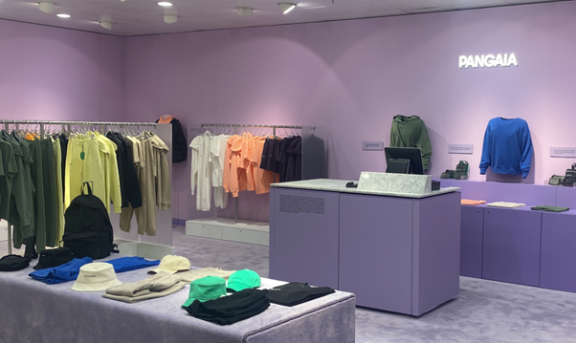
Source: Forward in Fashion
Styles
Popular fashion sportswear styles include:
- Jogging trousers (sweat pants with drawstring waistband and ankle cuffs)
- Sweatshirts (sporty, comfortable cotton long-sleeve shirts)
- Hoodies (comfortable cotton long-sleeve shirts with or without front closure and hood)
- Yoga pants (very tight trousers from stretch material that started the fashion sportswear trend)
- T-shirts (simple jersey shirt with varying sleeve lengths and necklines)
- Tracksuits (loose tops with zipper closure and matching loose trousers with drawstring waistband)
- Easy-wear styles (casual wear items with sporty features, such as costume trousers with drawstring)
Printing
Printed fashion sportswear items are often included in European fashion collections. There are different printing techniques: lithography (using printing plates and rollers on fabric), digital printing (inkjet and laser, allows for small production runs), and screen printing (transferring images onto fabric or garments that use a fine material or mesh/film). Printing can be outsourced but having your own printing and embroidery machines improves your flexibility.
Communication
Smooth communication is an implicit requirement with all buyers. Always reply to every email within 24 hours, even if it is just to confirm that you have received the email and will send a more complete reply later. If you have a problem with a production order, immediately notify the customer and try to offer a solution. Another good tip is to create a critical path of every order and share it with your buyer. This file will help you manage expectations and monitor progress, and it is the best guarantee of on-time delivery.
Flexibility
If you want to start a business relationship with a European buyer, be prepared to accept complicated orders first. Buyers will want to test your factory before giving you large, easy orders. Make sure that buyers will not continue to exclusively place difficult orders with you and convenient orders elsewhere at the start.
In their first orders, expect European buyers to require:
- High material quality and impeccable workmanship
- Order quantities below your normal minimum order quantity (MOQ)
- A price level lower than what you would normally accept for small-quantity orders
To improve flexibility, factories may install a sample room to produce small orders, a modular production set-up (island instead of production line) or a U-shaped set-up, in which employees can control several machines at the same time.
What are the requirements for niche markets?
As a hybrid of sportswear and casual wear, there are as many subcategories of fashion sportswear as there are sports and clothing styles. Consumers increasingly wear sports items when not exercising, and classical casual items like chinos and jeans are being designed with sporty features, such as stretch and breathability. Fashion sportswear is about creating clothing lines that boost performance and comfort while looking good.
Loungewear
An even more informal offshoot of the fashion sportswear trend is loungewear: extremely comfortable styles designed for wearing in and around the house. Check Rituals and Anthropologie for inspiration.
Sustainable fashion sportswear
More European fashion sportswear companies are using sustainable materials in their collections, such as natural and recycled fibres. Have a look at the following materials and production methods for examples:
- Organic cotton. This is cotton grown without the use of GMOs (‘genetically modified organisms’) and synthetic chemicals. Read more about organic cotton in CBI’s study on sustainable cotton.
- Use of fabrics blended with eco-friendly fibres. These include hemp, regenerated fibres such as Tencel®, Modal® and Refibra™ (by yarn manufacturer Lenzing), other sustainable fibres, such as Recover, REPREVE and Infinited Fiber, and even innovative bio-based polymer fibres like PLA, milk, seaweed and soy.
- Saving water during production by dyeing fabrics with new techniques (using carbon dioxide instead of water), such as Dyecoo.
- Fabrics dyed with only natural ingredients, such as Fibre Bio, Greendyes and dyes made from recycled materials like Recycrom.
To ensure quality (and in some cases also environmentally respectful production methods), buyers may nominate a supplier. For instance:
- DuPont for Lycra®
- Gore for Gore-tex™ and Gore-tex Infinium™
- ECONYL® for regenerated Nylon or Waste2Wear® for rPET (recycled PET)
Special sizes
Ever more European fashion brands have started to include silhouettes in their size range for specific body types, such as plus size, petit, tall and maternity fashion. Take a look at the UK brand Tala. If you are a manufacturer of tubular knits, you may be required to invest in bigger machinery to make large-sized styles.
Adaptive wear
Adaptive apparel is a niche that caters to the individual requirements of consumer groups, such as disabled people and the elderly. The target group is underserved but growing. This category has a lot in common with fashion sportswear in terms of styling and comfort. Be aware that adaptive wear has very specific requirements regarding safety and functionality. Read CBI’s study on adaptive apparel.
Local heroes wear
Success in sports affects demand in local European markets. Max Verstappen’s success in Formula One racing, for instance, has led to an increase in F1-styling features in fashion sportswear collections sold in the Netherlands. Jannik Sinner’s success in tennis has had a similar effect in Italy. When European countries do well during sports events, such as the European Football Cup, expect brands to take inspiration from the sport for their collections.
Custom-made sportswear
Many sports clubs need custom sportswear in their clubs’ colours. There are many companies that serve this large market. Due to the large variety of different sports, having a diverse collection is recommended. If you want to target sports clubs, try to serve companies like Jako.
2. Through which channels can you get fashion sportswear on the European market?
Before you approach European fashion sportswear buyers, you need to determine what market segment fits your company best and which sales channel(s) you want to sell your product through.
How is the end market segmented?
European fashion sportswear buyers can best be classified by price/quality level.
Table 2: Fashion sportswear market segmentation
| Consumer type | Price level | Characteristics | Material use | Functionality | Order Quantities |
| Luxury consumers | Very high retail prices | High comfort, fashionable designs and shapes | Highly innovative, luxury materials | Very high requirements regarding design | Low order quantities |
Mainstream fashionable consumers | Medium retail prices | Combination of sports and casual multi-purpose items, brand image | Good quality, sometimes sustainable materials | High requirements regarding comfortability | High order quantities |
Price-conscious consumers | Low retail prices | Basic styles with a focus on comfort with a sporty design | Medium-low quality materials | Low functionality | High order quantities |
Source: FT Journalistiek
Luxury consumers
High-fashion consumers shop at luxury brands and retailers, such as Moncler and Colmar, and high-fashion brands, such as Gucci and Burberry. These consumers expect their fashion sportswear to have a strong brand image and the latest fashion trends in sportswear, with a focus on maximum comfort. Fashion sportswear brands in the luxury market require top-quality materials and manufacturing, the latest technical innovations and highly comfortable designs.
Amateur athletes and fashionable fashion sportswear consumers
In the middle market, lifestyle sportswear brands like Adidas, Puma and Brunotti cater to amateur athletes and fashion sportswear consumers. These companies sell collections created around a brand image and offer good-quality products for a mid-level price. Products must have the technical look of a high-end product, but retail prices should be substantially lower.
Price-conscious consumers
The budget market includes companies like Decathlon, H&M and Sport 2000, which cater to the price-conscious recreational athlete and fashion sportswear consumer. Design and technical innovation are less important, but the apparel item needs to give the impression that it is fit for purpose and in line with the latest fashion trends. Prices are low, and competition is heavy in this market segment, both with regard to retail and to manufacturing.
Sustainability-conscious consumers
It is worth mentioning that an increasing number of European end consumers are buying fashion sportswear that is produced sustainably, including consumers that shop on the second-hand market. They appreciate fashionable designs but are more accepting of toned-down features. Their requirements regarding material use and functionality are similar to those of amateur athletes and fashionable consumers.
Tips:
- Check online shopping platforms for fashion sportswear like Yoox (luxury and upper middle market segments) Zalando (all market segments) and Asos (middle and budget market) for inspiration on styles and colours.
- Collaborate with EU-based distributors, wholesalers or retailers to gain market access. Do not forget to choose an entry strategy, whether exporting directly to retailers, participating in trade fairs or establishing a local presence.
Through what channels does the product end up on the end market?
The buyer’s place in the value chain will determine how they do business with you. Each buyer requires a specific approach. Always try to find out which part of the value chain your buyer operates in, what challenges they face in the market and how you can contribute to their sales strategy.
Table 3: Apparel sales channels on the European market
| Sales channel | Who is your buyer? | Requirements | Examples |
| 1 | European end consumer | You will need to invest in a web shop, stock, order management and customer service. Your biggest challenges will be return policies and a lack of brand awareness. Note that online B2C platforms may require a percentage of each sale and/or a monthly fee. | Rakuten (Spain and France), Allegro (Poland), Bol (Netherlands, Belgium), |
| 2 | Online multi-brand platform | Online multi-brand platforms sell existing brands and often develop their own private collections, mostly value brands. They can detect market interest very quickly and will immediately react to sales data. Usually, these companies will place a small test order first. If the item sells well, they will place the actual production order. Fast delivery is a must. | Boozt (Scandinavia), La Redoute (France), Yoox |
| 3 | Retailer | Fashion sportswear is sold by big retail chains in shops and online and by smaller boutique shops that can be found in almost every European city. Retailers sell existing brands and may order collections specially developed and manufactured for them. | |
| 4 | Brand | Apparel brands typically develop collections six to nine months in advance. You will need a sample room, as brands require salesman samples (SMS) of each collection style. Every salesman sample needs to be accurate: they must look exactly like the product will in the shop. It may take many months before orders are placed. | Adidas, Puma, Fila, Le Coq Sportif, |
| 5 | Intermediary | Agents, traders, importers and private label companies sell your product on to buyers up the value chain. They are extremely price-focused and require flexibility in quantities and qualities. Some are located near or in the production countries and primarily do sourcing and logistics, others work from Europe and also do market research, design and stock keeping. Their service level determines the commission rate they charge. | Li & Fung, Miles Group, Dewhirst |
Source: FT Journalistiek
The figure below shows the many ways you can get your product on the European market through an intermediary, your own brand, another brand, retailers or online platforms. Notice how, ideally, consumers return their apparel items to the seller to be reused, repaired, refurbished or recycled after use.
Figure 3: Apparel market value chain
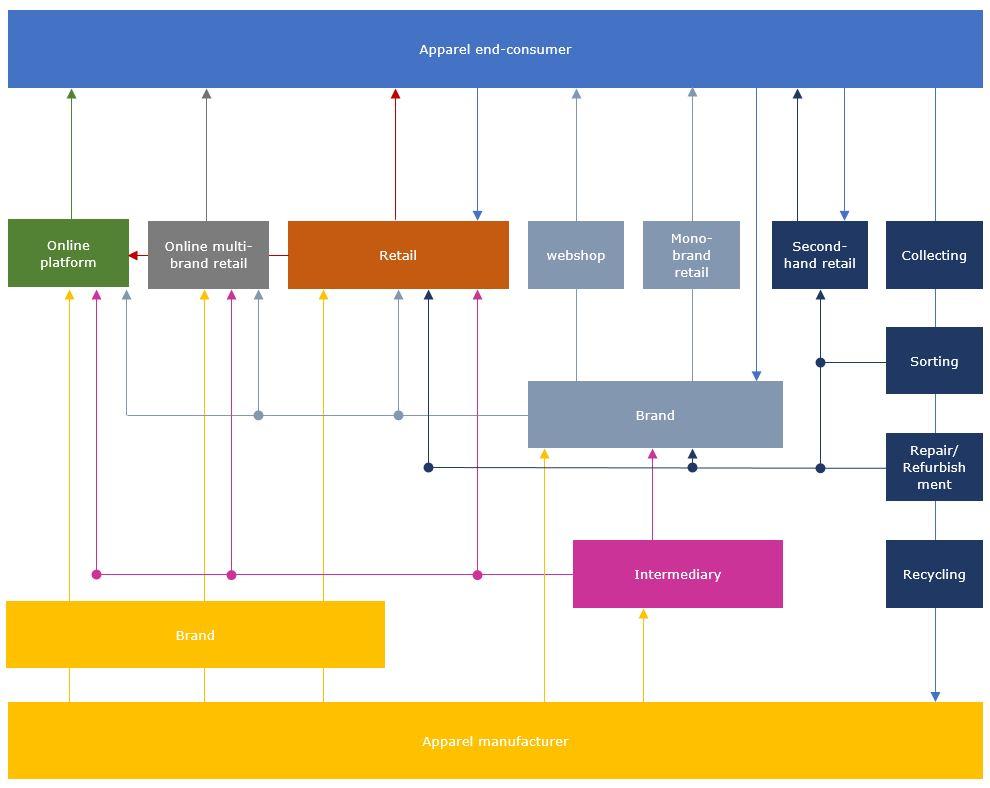
Source: FT Journalistiek
What is the most interesting channel for you?
As you move higher up the value chain, your margins will increase, but so will the service level that your buyer requires from you. If you do not have a lot of experience exporting to Europe, intermediaries and brands are likely the best starting point for you. Intermediaries have the largest market share, service every price and quality segment of the market and they are used to working with suppliers in different production countries around the globe.
Tips:
- Find potential buyers on the exhibitor list of the ISPO trade fair for sportswear and fashion sportswear in Germany. If you plan to meet a (potential) buyer at a fair, check what collections they have, buy one or two items and prepare matching or even improved samples. Also work out the costing before you introduce your company and your samples to a potential buyer.
- You can find intermediaries specialised in fashion sportswear by using an online search engine. Use keywords such as ‘full service’, ‘garment’ or ‘fashion sportswear’ plus ‘solution’. Traders’ websites usually show the brands they are working with.
- Be on top of new technical developments in the market. Be an advisor next to a producer to create advantages over the competition.
3. What competition do you face on the European fashion sportswear market?
Fashion sportswear is manufactured worldwide, so you will likely face stiff competition in this market. The most important ways to create a competitive advantage over manufacturers in other countries are: technical knowledge, service level, flexibility to accept lower MOQs, efficiency and beneficial trade agreements.
Which countries are you competing with?
Table 4: Competing countries
| Country | Strengths | Weaknesses | Image in Europe | Future developments |
China | Scale, technical innovation, high efficiency, excellent customer service and local availability of materials | Inconsistent quality standards, rising labour and production costs and no General Scheme of Preferences (GSP) | Flexible and innovative | Even though companies are no longer fully focussed on China, it is still not possible to manufacture apparel without some dependence on the Chinese supply chain. |
| Bangladesh | Scale, experience, low production and labour costs and the GSP. | Lower technical skill than China, relatively high MOQs and lagging behind in compliance. | Fit for volume business. Challenging labour standards | Massive investment in sustainable manufacturing. Growing business and diversification. |
Vietnam | High efficiency levels, relatively low production costs. No GSP but a new free trade agreement with the EU. | High MOQs, lack of local fabrics, accessories and trims | Volume business and mainly focussed on the US export market | The Vietnamese apparel sector will remain an industry with a focus on exporting high volume orders to the US market. |
| Cambodia | Upcoming production country. Many factories are being set up by foreign investors, which also supply their expertise. | Relatively inexperienced and relatively small workforce. No GSP. | Volume business with local governmental challenges | Development of the apparel industry depends on local government policy. The country still has a long way to go to comply with international standards. |
| Jordan | Experience in primarily supplying larger brands in the US. Growing fast thanks to new export-promoting regulations to the EU. | Still relatively unknown to European buyers, relatively high labour costs. | Mainly export to the US market based on Chinese fabrics supplied by buyers. | The apparel industry is growing but will mainly focus on expanding exports to the US market. |
| Turkey | Close to the EU, very short lead times. High-quality apparel in small quantities. A European business culture. Turkish manufacturers accept payment in euros. | Relatively high labour and production costs. | High flexibility but becoming expensive due to inflation and increasing costs | As soon as the local economy is stabilised, the apparel industry will increase in size. |
Source: FT Journalistiek
Tips:
- Study the countries you compete with, compare their strengths and weaknesses to yours, and advertise the competitive advantages of doing business with you. Besides GSP, consider factors such as distance to Europe, ease of doing business, transparency, political stability and general CSR compliance.
- Check whether and how other countries benefit from the Generalised Scheme of Preferences on the EU’s website on international trade.
- Most online search engines will let you create a news alert on a topic, so you can automatically follow the latest developments in the apparel industry in a specific country.
Which companies are you competing with?
Dopoo Sportswear in China is a full-service manufacturer of fashion sportswear and sportswear items. The company offers inhouse design, printing, cutting, sewing and packing. Dopoo is a flexible company (low MOQs) with short lead times. Its services are described on a user-friendly website, including a concise FAQ page (frequently asked questions). The company is ISO9001 and WRAP-certified.
Eco Couture is a vertically integrated full-service Bangladeshi apparel manufacturer. The company exports fashion sportswear and sportswear to buyers such as PUMA, VF Company and Marks & Spencer. Eco couture is part of the Viyellatex Group, which invests in sustainable operations (energy saving technology, waste treatment) and social compliancy. The company is ISO 14001, GOTS, CmiA and Oeko-Tex 100 certified. VIYELLATEX prides itself on being the only organisational stakeholder of the Global Reporting Initiative (GRI) in Bangladesh.
Eclat is a publicly listed vertically integrated Taiwanese full-service fashion sportswear and sportswear manufacturer that produces in both Taiwan and Vietnam. The company develops and produces highly technical fabrics and innovative fashion sportswear items and performance wear for buyers such as Nike, PVH and ASOS. It is also highly dedicated to saving energy and water during production. Eclat is ISO14001, ISO14061-1, Oeko-Tex 100 and Bluesign® certified.
Tips:
- Take a look at the free online database Open Apparel Registry. This website lets you look up the suppliers of hundreds of European fashion brands, including sportswear buyers.
- Read CBI’s study 11 Tips for Doing Business with European Buyers to learn how to approach and engage with buyers. This report also describes how you can get practical help with understanding European business culture, analysing your USPs and doing business with European buyers.
Which products are you competing with?
Fashion sportswear is entering other categories and creating completely new trends. By definition, it competes with sportswear and casual wear. Competition is mainly the result of overlapping qualities and styles.
Materials
Traditional sportswear fabrics like nylon and polyester are increasingly being replaced by new materials. Some of these materials are appreciated by buyers for their natural qualities, such as bio-cotton, wool, bamboo and Tencel®. Others are primarily used because of how sustainable they are, such as recycled polyester, nylon and elastane. The two most common weaknesses of these materials are low availability and high price point.
Tip:
- Consider using natural materials for your fashion sportswear. A lot of fashion sportswear is still polyester-based, but many consumers prefer natural materials over synthetics. This is especially true for fashion sportswear, as consumers tend to wear these items of clothing while doing activities other than sports.
4. What are the prices of fashion sportswear on the European market?
The factory price of your product is influenced by many factors, such as the cost of materials, the efficiency of your employees and your overhead and profit margin. For a step-by-step guide on how to calculate the FOB price of an apparel item, read this CBI study on cost price calculation.
The average cost breakdown of your FOB price (Free On Board) should look like this:
Source: FT Journalistiek
Retail pricing
The retail price of an apparel item is on average four to eight times the FOB price (this is called the ‘retail markup’). It follows that the FOB price is, on average, 12.5-25% of the retail price of the product. There are exceptions. In the budget market, some large European retail chains may double the FOB price mark-up. Retailers mark up the FOB price by four to eight times because they need to account for import duties, transport, rent, marketing, overhead, stock keeping, markdowns and VAT (15-27% in EU-countries), among other things.
These percentages may vary per factory, per order and over time. Some factories accept lower profit margins during the off-season or if order volumes are high. In addition, the percentages for labour versus fabrics may differ, depending on the efficiency and wage level of the workforce, and the price of the materials. Higher costs due to inflation, increasing taxes, sustainability requirements, lower quantities and near-shoring can also lead buyers to adopt bigger margins.
Source: Eurostat 2023
According to Eurostat’s 2023 comparison of retail prices for apparel in Europe, of the top three European importers of apparel, the Netherlands has the highest price level at 106.8 points compared to the European average of 100, followed by France (103.8) and Germany (98.8). Denmark is the EU country with the highest price point (130.7), while Switzerland is the most expensive European country for apparel (144).
Tips:
- Check this CBI study on cost-price calculation for a step-by-step guide on how to calculate your FOB price and tips on how to develop a pricing strategy.
- Read the CBI study 10 Tips for Doing Business with European Buyers to learn how to approach and engage with buyers.
Frans Tilstra and Giovanni Beatrice for FT Journalistiek carried out this study on behalf of CBI.
Please review our market information disclaimer.
Search
Enter search terms to find market research
